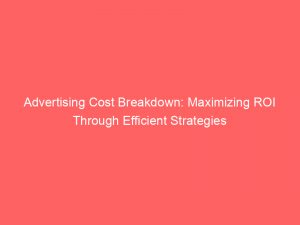- advertising cost
- Introduction To Advertising Costs
- Categorization Of Advertising Costs As SG&A Expenses
- Budgeting For Advertising Costs
- Setting Goals For Maximizing ROI
- Recording Advertising Expenses On The Balance Sheet
- Differentiating Between Advertising And Promotions
- Evidence Of Advertising’s Revenue-Boosting Effectiveness
- Measuring The Effectiveness Of Advertising Expenditure
- Overview Of Google Ads’ Cost And Reach
- Overview Of Facebook And Instagram’s Advertising Costs And Options
In today’s competitive business landscape, the importance of effective advertising cannot be overstated. Companies of all sizes and industries allocate significant resources to reach their target audience and enhance brand visibility.
However, the world of advertising can be a complex and costly endeavor. From setting clear objectives to selecting the right platforms, businesses need a strategic approach to make the most out of their advertising investments.
In this article, we will delve into the realm of advertising costs, exploring how businesses can navigate this terrain to maximize their return on investment. So, buckle up and get ready to uncover the secrets behind successful advertising campaigns.
| Item | Details |
|---|---|
| Topic | Advertising Cost Breakdown: Maximizing ROI Through Efficient Strategies |
| Category | Ads |
| Key takeaway | In today's competitive business landscape, the importance of effective advertising cannot be overstated. |
| Last updated | December 27, 2025 |
advertising cost
Advertising cost refers to the expenses incurred in promoting a brand, product, or service through various media outlets. These costs are typically categorized as sales, general, and administrative (SG&A) expenses on a company’s income statement.
Business owners usually allocate a budget for advertising costs, with small businesses spending around 1% of their annual income on advertising. To maximize return on investment (ROI), it is important for businesses to set specific goals and develop a program around them.
Advertising expenses can be recorded as prepaid expenses on the balance sheet and then transferred to the income statement when sales connected to those costs are generated. It is worth noting that advertising expenses differ from promotional expenses, which aim to increase brand awareness.
Numerous studies have demonstrated the effectiveness of advertising in boosting revenues. To measure the effectiveness of advertising expenditure, metrics like the advertising-to-sales ratio can be used.
Platforms like Google Ads offer online advertising campaigns, with an average cost per click ranging from $1.00 to $2.00. Small businesses typically spend between $9,000 and $10,000 per month on Google Ads.
Facebook is another popular and affordable advertising platform, with an average cost per click of $1.72 and an average cost per 1,000 impressions (CPM) of $7.19. Similar to Facebook, Instagram ads have a comparable pricing model with an average CPM of around $10.
Testing different options and strategies is crucial in reducing cost per click (CPC) and overall advertising costs. For businesses looking to optimize their ad budget and attract relevant traffic, hiring a digital marketing agency can be beneficial.Key Points:
- Advertising cost refers to expenses incurred to promote a brand, product, or service through various media outlets.
- Business owners typically allocate a budget for advertising costs, with small businesses spending around 1% of their annual income on advertising.
- Advertising expenses can be recorded as prepaid expenses on the balance sheet and then transferred to the income statement when sales connected to those costs are generated.
- Metrics like the advertising-to-sales ratio can be used to measure the effectiveness of advertising expenditure.
- Platforms like Google Ads and Facebook offer online advertising campaigns with varying costs per click and impressions.
- Testing different options and strategies is crucial for reducing CPC and overall advertising costs, and hiring a digital marketing agency can be beneficial for optimizing ad budgets.
Sources
https://www.investopedia.com/terms/a/advertising-costs.asp
https://www.lyfemarketing.com/blog/average-advertising-costs/
https://www.webfx.com/blog/business-advice/the-cost-of-advertising-nationally-broken-down-by-medium/
https://www.topdraw.com/insights/is-online-advertising-expensive/
Check this out:
💡 Pro Tips:
1. Consider alternative advertising platforms: While Google Ads and Facebook are popular choices, there are other platforms like LinkedIn, Twitter, and Pinterest that may be more cost-effective for your specific target audience.
2. Leverage social media influencers: Collaborating with influencers in your industry can be a cost-efficient way to reach a larger audience and generate brand awareness. Research and choose influencers whose followers align with your target market.
3. Optimize your landing pages: Ensure that your website landing pages are well-designed and optimized to convert visitors into customers. A high conversion rate can reduce your overall advertising costs by maximizing the return on your ad spend.
4. Use retargeting campaigns: Implement retargeting campaigns to reach people who have previously visited your website or engaged with your brand. This strategy can be highly effective in converting potential customers who are already familiar with your brand.
5. Monitor and analyze advertising metrics: Regularly track and analyze the performance of your advertising campaigns. Identify which channels and specific ads are driving the most conversions and adjust your strategy accordingly to minimize wasted ad spend.
Introduction To Advertising Costs
Advertising costs refer to the expenses associated with promoting a brand, product, or service through various media outlets. These costs play a crucial role in the success of a business as they help create brand awareness, attract new customers, and generate sales.
Companies allocate a portion of their budget towards advertising to reach their target audience and increase market share. Effective advertising strategies can significantly impact a company’s bottom line, making it a necessary investment for businesses of all sizes.
Data refreshed to reflect current ad-spend trends.
Categorization Of Advertising Costs As SG&A Expenses
Advertising costs are typically categorized as sales, general, and administrative (SG&A) expenses on a company’s income statement. These expenses represent the money spent on advertising campaigns, promotional materials, media buying, agency fees, and other related activities.
By categorizing advertising costs under SG&A expenses, businesses can track and analyze their advertising spend alongside other operational costs. This helps in evaluating the effectiveness of advertising campaigns and making informed decisions regarding future marketing strategies.
Budgeting For Advertising Costs
Business owners often allocate a specific budget for advertising costs. Small businesses typically spend around 1% of their annual income on advertising.
However, the exact percentage may vary depending on factors such as industry, competition levels, and business goals. Setting a well-defined advertising budget allows businesses to determine how much they can afford to spend on various advertising activities while maintaining financial stability.
Setting Goals For Maximizing ROI
To maximize return on investment (ROI), businesses should set specific goals and develop a program around them. Defining clear objectives helps guide advertising strategies and allows for better measurement of campaign effectiveness.
Whether the goal is to increase brand awareness, drive website traffic, or generate direct sales, businesses need to align their advertising efforts accordingly.
Recording Advertising Expenses On The Balance Sheet
Advertising expenses can be recorded as prepaid expenses on the balance sheet and then transferred to the income statement when sales connected to those costs are generated. This accounting practice allows businesses to align the recognition of advertising expenses with the revenue generated from those efforts.
By accurately tracking and allocating advertising expenses, businesses can gain insights into the direct impact of their advertising efforts on their financial performance.
Differentiating Between Advertising And Promotions
It is important to differentiate between advertising expenses and promotional activities. While advertising focuses on paid promotion through various media outlets, promotions are separate from advertising expenses and are meant to increase brand awareness, generate immediate sales, or incentivize customer loyalty.
Promotions can include activities such as discounts, giveaways, contests, or other incentives that encourage customers to take immediate action.
Evidence Of Advertising’s Revenue-Boosting Effectiveness
Several studies have shown that advertising generally works to boost revenues. When done effectively, advertising helps increase brand visibility, attract new customers, and drive sales.
A well-executed advertising campaign can create a positive brand image, differentiate a company from its competition, and influence consumer purchasing decisions.
Measuring The Effectiveness Of Advertising Expenditure
The effectiveness of advertising expenditure can be measured using various metrics. One commonly used metric is the advertising-to-sales ratio, which measures the percentage of advertising expenses in relation to sales generated.
This ratio helps evaluate the efficiency and effectiveness of advertising campaigns and provides insights into the return on advertising investment.
Overview Of Google Ads’ Cost And Reach
Google Ads is the largest online advertising platform, offering search and display network campaigns. Businesses can create targeted ads that appear on search engine results pages and websites within the Google Display Network.
The cost of Google Ads varies based on factors such as keyword competitiveness, ad relevancy, and bid amounts.
Overview Of Facebook And Instagram’s Advertising Costs And Options
Facebook and Instagram are popular and affordable advertising platforms that offer sophisticated targeting options. With a large user base and advanced demographic targeting capabilities, businesses can reach their desired audience effectively.
In conclusion, advertising costs are a crucial aspect of any business’s marketing efforts. By understanding the breakdown of advertising costs, businesses can allocate their resources effectively, set measurable goals, and maximize their return on investment.
Regular analysis, testing, and optimization of advertising strategies can help businesses lower costs, increase revenue, and achieve long-term success in a highly competitive marketplace.
Performance Marketing Tips • Advertising Platform for Marketers • Programmatic Advertising











